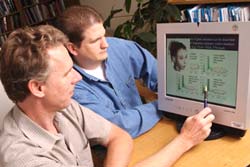Articles and reports from the Life Sciences and chemistry area deal with applied and basic research into modern biology, chemistry and human medicine.
Valuable information can be found on a range of life sciences fields including bacteriology, biochemistry, bionics, bioinformatics, biophysics, biotechnology, genetics, geobotany, human biology, marine biology, microbiology, molecular biology, cellular biology, zoology, bioinorganic chemistry, microchemistry and environmental chemistry.

Rutgers geneticist Tara Matise and her colleagues have produced a map that will help pinpoint the genes linked to such serious diseases as diabetes, high blood pressure and schizophrenia.
This linkage map is based on the amount of the interaction or recombination taking place among nearly 3,000 genetic markers whose positions are known. The markers used for the map are single-nucleotide polymorphisms (SNPs) – the variations of a gene that people may carry at one point on their DNA.

UT Southwestern Medical Center at Dallas researchers have discovered a tumor-suppressor gene that, in fruit flies, simultaneously restricts cell proliferation and promotes cell death, a process that may also play an important role in the genesis of cancer in humans.
Removal of the gene, hippo, resulted in tumor formation in every organ of the fruit fly. The findings, which are currently online, will appear in an upcoming issue of Cell.
“This is one of the few genes that has been d

Remain a hematopoetic stem cell or become a specialized blood cell?
Hematopoietic stem cells, the mother of all blood cells, face a fundamental dilemma in their lives.
Each must either remain a hematopoietic stem cell (HSC) by renewing itself or it must transform into one of eight specialized types of blood cells, such as a red blood cell, a white blood cell or a platelet.
Until recently, scientists didn’t know how the essential cells, which exist in limited a

UT Southwestern Medical Center at Dallas researchers have taken the first step in defining the sites in human genes most prone to mutation, which eventually could lead to discovery of the genetic bases of many human diseases.
Their work will appear in an upcoming issue of the journal Gene and is currently available online.
Dr. Harold “Skip” Garner, professor of biochemistry and internal medicine, and his colleagues made their discovery while mining databases of coding single nucle

’Lizards gone wild’
Despite social notions of race, human populations around the world are genetically so similar that geneticists find no different sub-species among them. The genetic continuity of human populations is the exception rather than the rule for most animal species, however.
Richard Glor, graduate evolutionary biology student in Arts & Sciences at Washington University in St. Louis, has found extensive genetic differentiation among populations of numero

’The brain’s Timex’
Getting over jet lag may be as simple as changing the temperature –your brain temperature, that is.
That’s a theory proposed by Erik Herzog, Ph.D. assistant professor of biology in Arts & Sciences at Washington University in St. Louis. Herzog has found that the biological clocks of rats and mice respond directly to temperature changes.
Biological clocks, which drive circadian rhythms, are found in almost every living organis